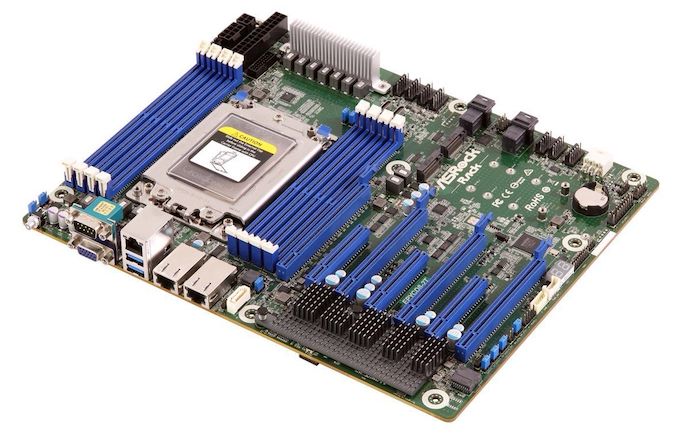The ASRock Rack EPYCD8-2T Motherboard Review: From Naples to Rome
by Gavin Bonshor on April 20, 2020 9:00 AM EST- Posted in
- Motherboards
- AMD
- Workstation
- server
- ASRock Rack
- Naples
- Rome
- EPYC 7351P
- EPYCD8-2T
ASRock Rack EPYCD8-2T Conclusion
Professional grade motherboards are a completely different playing field when it comes to the consumer-focused models. The main differences aside from featuring much plainer and archaic aesthetics, come via the onboard controller set. This includes the use of BMC controllers to allow users to connect for vital maintenance and monitoring from distant locations. ASRock Rack has been around since 2013 and until 2018, it produced models for Intel. The first board created for AMD';s EPYC from ASRock Rack was the EPYCD8, with the primary difference between that and the EPYCD8-2T coming through its choice of primary networking controller. The newer EPYCD8-2T includes an Intel X550 Dual 10 G Ethernet controller which adds two ports on the rear. Everything else between both models remains unchanged.
The ASRock EPYCD8-2T includes seven PCIe 3.0 slots, which is an is an impressive feat given the board is ATX. They run in a x16/x8/x16/x8/x16/x8/x16 configuration, with the four full-length slots running at the full x16 bandwidth, and the half-length slots running at x8. One of the biggest benefits of AMD's EPYC is that each processor has 128 available PCIe lanes, which the ASRock model takes full advantage of. Also benefiting from the PCIe capability is two PCIe 3.0 x4 M.2 slots, with two Oculink slots for U.2 drives, with support for up to nine SATA devices via two mini SAS HD ports, with a single SATA DOM powered connector.

The ASRock EPYCD8-2T has seven PCIe 3.0 slots
To connect remotely to a system using this model, users can access it over a network using a Realtek RTL8211E Gigabit Ethernet port designed for the boards IPMI. The Aspeed AST2500 BMC adds a D-sub 2D video output on the rear panel which allows users to run without a graphics card installed. The management interface itself is very well-rounded with a clean GUI and offers plenty of server-level functions. The memory support includes eight slots which support up to DDR4-3200 of RDIMM and LRDIMM ECC memory and a maximum capacity of up to 1 TB.
Looking at the performance, and the EPYCD8-2T is very competitive from a computational standpoint. The real difference came in our power consumption testing which puts it as the more power-efficient model when compared directly to the GIGABYTE model. Another highly positive result came in our DPC latency testing, with the lowest latency achieved from any model tested over the last few years. This makes the EPYCD8-2T very suitable for an audio workstation, despite not including any onboard audio; audio producers generally use much higher grade audio equipment anyway. Results in our POST time testing were also favourable with the ASRock board booting into Windows around 20 seconds quicker than the GIGABYTE counterpart.
Bigger sized boards such as E-ATX models can cram more memory slots on, but the EPYCD8-2T is 'ahead' of its size in terms of specifications with its great storage capability spearheaded by dual PCIe 3.0 x4 M.2 slots, and support for up to nine SATA drives. The ASRock EPYCD8-2T retails for $498 with dual 10 G Ethernet, or alternatively users satisfied with dual Gigabit Ethernet can save some budget with the EYPCD8 ($460) coming in at around $40 cheaper. For comparative purposes, the larger E-ATX sized GIGABYTE MZ31-AR0 which we previously reviewed retails for $565, had more memory slots (16 versus 8) and offering up to 2 TB. Being ATX means the ASRock EPYCD8-2T is compatible with more chassis types, including 1U chassis, and conventional desktop cases.
Overall the ASRock Rack EPYCD8-2T is a solid single-socket EPYC solution for users not interested in PCIe 4.0 but still want plenty of PCIe and storage availability in a single socket ATX form factor.











34 Comments
View All Comments
sftech - Sunday, April 26, 2020 - link
Could you please add a photo of the underside of the board?Nahid070 - Wednesday, May 13, 2020 - link
We some of ryzen 3100 and 3300x paired with budget graphics cardsPyxar - Wednesday, December 23, 2020 - link
Given the offset from the back of the card slot area, I wonder if that is going to fit normal cases or need a special case?